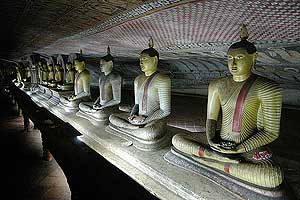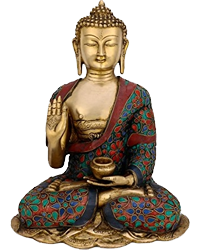 Inside the caves, the ceilings are painted with intricate patterns of religious images following the contours of the rock. There are images of the Lord Buddha and bodhisattvas, as well as various gods and goddesses.
Inside the caves, the ceilings are painted with intricate patterns of religious images following the contours of the rock. There are images of the Lord Buddha and bodhisattvas, as well as various gods and goddesses.
The temple is composed of five caves, which have been converted into shrine rooms.
The caves, built at the base of a 150m high rock during the Anuradhapura (1st Century BC to 993 AD) and Polonnaruwa times (1073 to 1250), are by far the most impressive of the many cave temples found in Sri Lanka.
Access is along the gentle slope of the Dambulla Rock, offering a panoramic view of the surrounding flat lands, which includes the rock fortress Sigiriya, 19kms away. Families of friendly monkeys make the climb even more interesting. Dusk brings hundreds of swooping swallows to the cave entrance.
The largest cave measures about 52m from east to west, and 23m from the entrance to the back, this spectacular cave is 7m tall at its highest point. Hindu deities are also represented here, as are the kings Valgamba and Nissankamalla, and Ananda - the Buddha's most devoted disciple.
Within these shrine rooms is housed a collection of one hundred and fifty statues of the Buddhist Order and the country's history. These statues and paintings are representative of many epochs of Sinhala sculpture and art. The Buddha statues are in varying sizes and attitudes - the largest is 15 metres long. One cave has over 1,500 paintings of Buddha covering the ceiling.
The Dambulla cave monastery is still functional and remains the best-preserved ancient edifice in Sri Lanka. This complex dates from the 3rd and 2nd Centuries BC, when it was already established as one of the largest and most important monasteries. King Walagambahu is traditionally thought to have converted the caves into a temple in the 1st century BC.
Exiled from Anuradhapura, he sought refuge here from South Indian usurpers for 15 years. After reclaiming his capital, the King built a temple in thankful worship. Many other kings added to it later and by the 11th century, the caves had become a major religious centre and still are. King Nissanka Malla gilded the caves and added about 70 Buddha statues in 1190. During the 18th century, the caves were restored and painted by the Kandyan Kings.
The first cave
The first cave is called Devarajalena, or "Cave of the Divine King." An account of the founding of the monastery is recorded in a first-century Brahmi inscription over the entrance to the first cave.
This cave is dominated by the 14-meter statue of the Buddha, hewn out of the rock. It has been repainted countless times in the course of its history, and probably received its last coat of paint in the 20th century. At his feet is Buddha's favorite pupil, Ananda; at his head, Vishnu, said to have used his divine powers to create the caves.
The second cave
In the second and largest cave, in addition to 16 standing and 40 seated statues of Buddha, are the gods Saman and Vishnu, which pilgrims often decorate with garlands, and finally statues of King Vattagamani, who honored the monastery in the first century B.C., and King Nissanka Malla, responsible in the 12th century for the gilding of 50 statues, as indicated by a stone inscription near the monastery entrance.
This cave is accordingly called Maharajalena, "Cave of the Great Kings." The Buddha statue hewn out of the rock on the left side of the room is escorted by wooden figures of the Bodhisattvas Maitreya (left) and Avalokiteshvara or Natha (right). There is also a dagoba and a spring which drips its water, said to have healing powers, out of a crack in the ceiling.
Valuable tempera paintings on the cave ceiling dating from the 18th centurydepict scenes from Buddha's life, from the dream of Mahamaya to temptation by the demon Mara. Further pictures relate important events from the country's history.
3rd, 4th and 5th caves
The third cave, the Maha Alut Vihara, the "Great New Monastery," acquired ceiling and wall paintings in the typical Kandy style during the reign of King Kirti Sri Rajasinha (1747-1782), the famous Buddhist revivalist. In addition to the 50 Buddha statues, there is also a statue of the king.
The fourth and fifth caves are smaller; they date from a later period and are not of such high quality. A small Vishnu Devale between the first and second caves attracts many worshipers.




